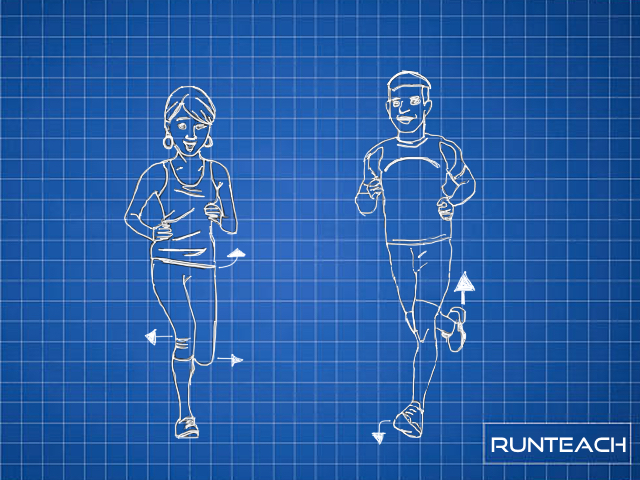Lesson 7 – Running Technique
This post relates to my Blueprint for running, which is free to download here – from my other site, The Confident Runner.
Firstly, from the next email they will be titled Lessons From The Blueprint as I now want to dive more into helping you improve your technique.
In the last lesson, we started looking at what you want to achieve in terms of your running technique, and I laid out the main markers that I use.
I want to follow that up with step number two of the Blueprint, which is Where are you now? If you need a free copy of Blueprint for Running, you can download it here: Blueprint for Running from the Confident Runner website.
I’ve been conducting running assessments for several years, and the way I’ve done them has evolved over that time. Since becoming a Z-Health Certified Practitioner, I now look at things very differently than I did just a year or so ago.
Now is a great time to point out that running is an incredibly complex activity with so much integration and patterning going on. This is why it’s always best to go to a specialist if you really want to improve your running technique. I’ll write a separate topic on choosing a running assessment specialist, because like all areas of life, not all services that claim to be able to help can actually help you over the longer term.
Having said all this, there is still a lot that you can discover for yourself, and I’ve tried to make it as easy as possible to do that by providing you with a self-assessment sheet inside the Blueprint eBook. There is an instruction sheet that goes with it, which is linked to from within the self-assessment document.
This email is going to start building on those instructions so you can get the most out of the assessment, and we’re going to start with the sound of your feet.
Have a think about these:
- Why can the sound your feet make when you run tell you about your technique?
- Does the sound change depending on the surface you run on?
- Does the sound change with different shoes, or barefoot?
- Does the sound change with the pace run at?
Becoming conscious of the sound your feet make when you run can really help you improve your technique. In fact, this can be one of the most important factors to measure. Of course, measuring the sound is not going to be a technical or super accurate thing for most of us, it’s going to be about carefully listening.
So, why is the sound your feet make when you run so important?
At the most simple level, it can indicate how hard you hit the ground with every step. Now, you may think that being overweight will cause you to hit the ground harder than if you were lighter, but that isn’t actually the case. I’ve seen very slim kids hit the ground much harder than way heavier adults.
How hard you hit the ground is often an indication of how much muscle control you have at the various points in your gait cycle, most notably at the point your foot makes contact with the ground (but can be driven from any part of the cycle). This is important for the following main reasons:
- Overuse injuries can result from inefficient muscle control as the loads are unbalanced and forced onto muscles that aren’t necessarily able to cope with those forces.
- Ordinarily, a runner will put between three and five times their body weight through their feet with every step. Inefficient muscle control can see this going up to six times or higher. That’s a lot of force!
- Poor muscle control leads to energy leakage and can make for a very tiring run. If your running feels like it’s way too much effort than it should be, you may have some muscle control issues going on.
For most of us, determining which muscles are lacking the required control can be difficult. It has taken me years of experimenting and practice in gait analysis and some really in-depth education to get a good idea of where to start. But everyone is different so I can’t actually give you a precise answer in this email.
However, I can give you some clues as to where to start. Firstly, your hamstrings help control the deceleration as you hit the ground. They also help control the deceleration of your legs before they hit the ground. If they are not doing their job properly, you can get some pretty heavy landing going on.
Your calves and connective tissue also play a crucial role in absorbing energy as you run, so if these muscles aren’t playing their role, then you can literally run into all kinds of issues with force loading and heavy landings.
Finally for now, your shin muscles play an important role in foot control. Runners rarely do any exercises that specifically target their shin muscles, do you? If not, it’s about time you learn to activate and use them better. If your foot isn’t well controlled throughout all parts of the running gait cycle, your feet can be in the wrong place as they make contact with the ground. This can lead to slapping down, loss of control on contact, excessive pronation and of course, heavy footed landing.
So, on the self-assessment form, Sound is a small box. But as you have just learned, it can tell you a great deal about how you run and whether you have inefficiencies that can lead to a higher injury risk and ploddy, heavy, unenjoyable running.
From my experience and training, sound also gives me clues as to how your brain and nervous system are integrating with your muscular system. As you’ll know by now, your nervous system controls everything. If there are any blips in the system, it can be difficult to make physical changes without the nervous system changes being made first.
In the next email we’ll keep going through the self-assessment and start to look at how you can assess your upper body.
Until then, spend some time listening to how you run, and what the sound may be telling you.
Unleash your hips is my online course designed to help you get those flying feet through better hip and pelvis mobility and improved running technique. Click Here to find out more.


